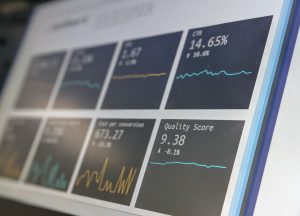Inventory forecasting is an essential part of successful supply chain management. Its goal is to ensure that there is enough stock available to meet the demands and not too much to lose money on unnecessary maintenance costs.

Inventory forecasting is for determining optimal stock levels and reach financial success.
Benefits of inventory forecasting

No over-stocking
Ordering excess inventory and keeping it in a warehouse covered with dust is not profitable for a business. It can cause high handling costs and an increased risk of stock perishment. Having well-calculated demands will save a company from excessive stock levels and expenses related to it. As a result, it will improve cash flow and free up funds for other business activities.
No under-stocking
The other side of over-stocking is facing stockouts. It happens when a business has no inventory on hand to meet the current sales demands. The direct impact of understocking is losing a potential sale. However, there can also be long-term consequences. When customers need specific products that are stocked out, they will choose a competitor brand and might never return. As a result, the business loses customers.
Efficient supply chain cycle
Proper inventory forecasting allows businesses to improve management through entire production processes. They can work more efficiently with their vendors and get better control over the production cycle when there are manufacturer’s lead time, delivery timelines, and exact inventory levels
As a result, there will not be a need to guess or order excess safety stock levels. With accurate forecasting, businesses can make informed and economically beneficial decisions.
Required information for inventory forecasting
There are several concepts introduced below that you need to know to make demand predictions.
Forecast period
The forecast period is the time for which you are estimating the necessary inventory quantities. The choice of the suitable period depends on the production cycle and inventory turnover rate, etc.
Trends
The trend is a change of demand through a specific frame of time. For example, a company selling coats will experience an increasing seasonal trend during the autumn and winter months. This data will be used when estimating stock ordering or production quantities.
Lead time demand
Lead time is the number of days that it takes your suppliers to deliver ordered products. To avoid stockouts, you need to predict sales numbers during the lead time.
Lead time demand = average lead time in days x average daily sales.
Reorder point
When you make sales, inventory levels decrease. There is an estimated point, called reorder point, that requires replenishment. The number is not fixed and should be calculated regularly depending on seasonal sales trends.
Reorder point is calculated with the following formula:
Reorder point = (average daily sales x lead time) + safety stock
Safety stock
Safety stock is the number of units kept in the warehouse to ensure that there will be no stockouts. Although safety stock may increase storage costs, sometimes it is necessary for handling demand fluctuations. The optimal amount of safety stock is calculated by the following formula:
Safety stock = (maximum daily sales x maximum lead time in days) – (average daily sales x average lead time in days)
Inventory turnover ratio
The term Inventory turnover ratio estimates how fast the stock is being sold during a specific period and, based on that, how frequently it needs to be replenished.
Inventory turnover = (cost of goods sold / average inventory)
A low inventory turnover ratio may indicate slow sales or overstocking. A high percentage may be a sign of strong sales or understocking. Depending on the industry, the perfect ratio may differ.
Inventory forecasting types
Customer demands are the key in each type of forecasting method. However, depending on the business profile and available data, inventory forecasters may choose a different model for stock planning. Following are some of the most popular forecasting techniques.
Trend forecasting
Trend forecasting models estimate future trend movements based on past sales and market growth data. Businesses calculate increasing or decreasing trends for each product or service and assess possible demands based on those models. Inventory managers can use trend forecasting of future sales to modify future stock realization strategies.
Graphical forecasting
A graphical forecasting model refers to bringing past sales data into visual forms. Graphical models allow more effective sales analysis because visible data is easier to comprehend. The ups and downs on the graphs point out stock statistics, patterns, and changes.
Qualitative forecasting
The qualitative forecasting method is proper when the previous sales data is unavailable or unreliable. This is usually the case for new businesses. This method suggests evaluating trends through professional knowledge and experience and by conducting market research.
Quantitative forecasting
This model gives a more accurate view because it estimates future sales based on previous sales data. Depending on the forecast goal, it takes the last month, quarter, or year data. Quantitative forecasting works best for settled businesses because they have more data available.
Inventory forecasting with software

Accurate inventory forecasting is a challenging task, especially in the case of a large variety of products and multiple vendors. Luckily, information technologies simplify and optimize demand forecasting.
There are inventory management systems, such as eSwap, that analyze all necessary sales data for forecasting. eSwap stock management software unites data from all inventory-related activities and provides accurate and essential decision-making. For example, it graphically shows sales and profit trends, inventory levels in different locations, active sales channels, etc.
Conclusion
In times of rapidly changing trends and more than ever-competitive markets, estimating demands accurately is an absolute necessity for a company’s financial success. While demand forecasting is a challenging task, it is still one of the most critical factors for effective supply chain management.
Unfortunately, despite all tools and techniques used, forecasting is an estimation that holds high levels of uncertainty. The goal is to continuously review and analyze data and statistics to reach the highest possible accuracy.







